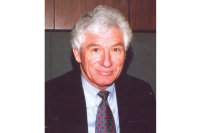The rise and rise of the American empire
H.W. Crocker’s Don’t Tread On Me: A 400-Year History of America at War, from Indian Fighting to Terrorist Hunting gives us the good, the bad, and the ugly versions of popular history.
First, the good: Crocker makes the reading of history both exciting and pleasurable. Don’t Tread On Me is the ideal book to give a young person in hopes of sparking an interest in American history or the American military. In addressing such a large topic — he covers 400 years of history in 399 pages, excluding notes — Crocker writes with verve and passion about American wars and the soldiers who fought them. He possesses the knack of looking at the big picture, at making what is complex understandable to the reader. He also has a gift for description. His account of the Mexican War, for example, makes clear the strategy of both the Americans and the Mexicans, examines the American tactics in battle and gives accounts of heroism on both sides, all while keeping the avid interest of the reader.
Crocker also shows us the “bad” side of his history. Though some of his reviewers have touted him as being “politically incorrect,” “provocative,” an “imperialist,” and a believer in the “American Empire,” some of us may find his performance in this regard ridiculous, if not shameful. From Washington to Eisenhower, from New England’s resistance to what became the War of 1812 to the anti-war mothers and wives of 1915 to the America First movement of the pre-World War Two era, America had a proud tradition of keeping its military small, its overseas ambitions limited.
“I didn’t raise my boy to be a soldier” was more than a verse to an American song; it was the motto of a nation that actually sought to be a light unto the world. Crocker seems determined to justify the American Empire, whereas many of us, liberals and conservatives both, wonder what in the hell the United States is doing as an empire.
Crocker becomes particularly unbearable whenever he sings the praises of the American military. He refers to the American soldier as an “American centurion.” He tells us that our military men and women maintain the Pax Americana. He writes that what sustains our solder “is pride in his profession — which he executes so very well — and a cultural confidence that too many of his fellow Americans on civvy street lack.” He argues that we need “a larger military ... We need only to pay and support our fighting men...” so that they aren’t risking the economic well-being of their families. I wonder if Crocker has checked out what a male in his 20s earns in Haywood County these days? Is it that much greater than his military counterpart? Or is it in fact lower, so low that he often lives in a mobile home and works two jobs simply to pay the rent?
Related Items
The baloney in this book comes from the confusion between the heroism of some Americans in battle and the mission of our military in the world. The former is determined by individuals and by unit pride; the latter is determined by politicians. Crocker’s failure to make this distinction, his inability or unwillingness to separate political policy from military performance, makes him appear either stupid or silly.
Don’t Tread On Me shows the ugly part of its face in some of the writing itself. In quoting Chesty Puller, the Marine who led his men back through a hell of snow and Chinese troops to Koto-Ri — “Christ in His mercy will see us through,” Puller said — Crocker writes that the Red Chinese “were atheists and known to be rather nasty.” Such statements pervade the book. Some of Crocker’s language is also odd. He writes, for example, on the last page of the book of “a war of civilizational self-defense,” when no such type — or word — regarding self-defense exists.
I recommend Don’t Tread On Me to history lite readers. Otherwise, avoid it.
•••
Mark Kriegel’s Pistol: The Life of Pete Maravich is a solid account of a great basketball player. Kriegel resists the temptation to psychoanalyze the often tormented Maravich. He tells us, for example, of the alcoholism and the subsequent suicide of Maravich’s mother Helen and his father’s constant pressure on his son to become basketball’s best, yet Kriegel rarely speculates on the forces that both drove and damaged Pete Maravich. Instead, he concentrates on bringing together what can be discovered about Maravich from documents and interviews.
Maravich was one of the first show-time basketball players, one of those athletes who was ahead of his time. His training as a boy at the hands of his father-coach, Press, taught Maravich moves that at the time had rarely been seen on a basketball court. Press’ teaching techniques included having his son dribble from a bicycle and from a moving car, creating dozens of original games and drills, and encouraging Pete each step of the way to become a better player, to make himself the best.
Kriegel ends his account where Jaeson and Josh, Pete’s sons, meet the student-manager of their father’s team at Louisiana State University. He shows them a pair of their deceased father’s shoes: low-cut Converse shoes known as Chuck Taylors. They begin talking about a shot made by Pete against Georgia:
Still, Jaeson and Josh are curious. They have never seen the shot, as no film exists. Did he bank it in? Was his back turned to the basket? How could he even see the rim?
It’s the crazy dude with the Chuck Taylors who knows the secret. He was there, looking right in Pete’s eyes as he put the ball up.
Pete didn’t need to see the basket.
It wasn’t something to see.
It was something to feel.
Still is.
“Joy,” says the crazy dude. “It was pure joy.”
Don’t Tread On Me: A 400-Year History of America at War, from Indian Fighting to Terrorist Hunting by H.W. Crocker. Crown Forum, 2006. 464 pages









